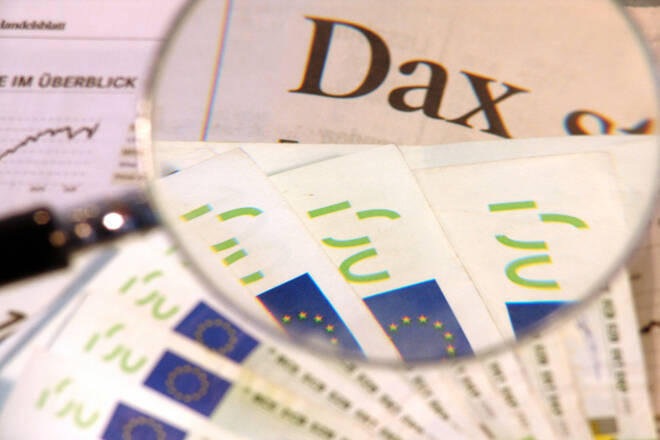Advertisement
Advertisement
DAX in the Hands of German and US Manufacturing Sector PMIs
By:
It is a busy day for the DAX, with manufacturing sector PMIs from the euro area and the US to draw interest as investors look for cracks in the economy.
It was a bullish Friday for the DAX, which rose by 0.69% to end the day at 15,629.
Disappointing economic data from Germany had a short-lived impact on the DAX. Easing market fears of a global financial crisis continued to deliver support, with investor bets of softer inflation numbers from the US also providing morning support.
Softer inflation numbers from Germany on Thursday and the euro area on Friday eased fears of more ECB interest rate hikes, supporting riskier assets.
In the afternoon session, US economic indicators were also market-friendly, with the NASDAQ Composite Index and Dow Jones joining the DAX in positive territory.
On Friday, the NASDAQ Composite Index rose by 1.74%, with the Dow Jones gaining 1.26%.
Economic Indicators and Easing Bank Jitters Delivered Support
Economic indicators from Germany were disappointing, with retail sales unexpectedly falling by 1.3% versus a forecasted 0.5% increase. In January, retail sales rose by 0.1%. A higher-than-expected rise in unemployment pushed the German unemployment rate from 5.5% to 5.6%. Economists forecasted the unemployment rate to hold steady at 5.5%.
Following softer German inflation numbers from Thursday, inflationary pressures also subsided in France. The French annual inflation rate eased from 6.3% to 5.6% versus a forecasted 5.5%.
The markets expected a similar trend for the euro area, with Spanish, German, and French inflation figures coming in considerably softer.
According to prelim figures, the euro area annual inflation rate softened from 8.5% to 6.9% versus a forecasted 7.1%.
According to Eurostat,
- Food, alcohol, & tobacco had the highest annual rate (15.4% v 15.0% in Feb).
- Non-energy industrial goods (6.6% v 6.8% in Feb) and services (5.0% v 4.8% in Feb) also contributed.
- However, the annual inflation rate for energy tumbled from 13.7% to -0.9%.
- The core annual inflation rate for the euro area accelerated from 5.6% to 5.7%
US economic indicators provided little reason for the Fed to lift interest rates again. The Core PCE Price Index increased by 4.6% in February versus 4.7% in January. Economists forecast a 4.7% increase.
The Market Movers
It was a mixed Friday for the auto sector. Volkswagen led the way, rising by 0.77%, with Continental and BMW seeing gains of 0.50% and 0.26%, respectively. However, Porsche and Daimler bucked the trend, falling by 0.38% and 0.18%, respectively.
It was also a mixed session for the banks. Commerzbank fell by 0.35%, while Deutsche Bank rose by 0.72%.
The Day Ahead for the DAX
It is a busier day ahead on the economic calendar.
Manufacturing sector PMIs for Italy and Spain and finalized PMIs from France, Germany, and the Eurozone will be in focus. We expect the PMIs for Italy, Germany, and the Eurozone to have the most impact.
US economic indicators will also provide direction, with the ISM Manufacturing PMI likely to draw plenty of interest. A deeper contraction in the manufacturing sector would weigh on the DAX.
Earlier today, disappointing PMI numbers from China set the mood. The Caixin Manufacturing PMI fell from 51.6 to 50.0. Economists forecast an increase to 51.7.
A surge in crude oil prices, fueled by an unexpected OPEC decision to cut output, added to the bearish mood. The jump in crude oil prices could undo the work of central banks to bring inflation to target.
DAX Technical Indicators
The DAX has to avoid the 15,596 pivot to target the First Major Resistance Level (R1) at 15,692. A move through the Friday high of 15,659 would signal a bullish session. However, the DAX would need economic indicators to support a bullish session.
In the case of an extended rally, the bulls will likely test the Second Major Resistance Level (R2) at $15,755. The Third Major Resistance Level (R3) sits at 15,914.
A fall through the pivot would bring the First Major Support Level (S1) at 15,533 into play. However, barring a flight to safety, the DAX should avoid sub-$15,500 and the Second Major Support Level (S2) at 15,437. The Third Major Support Level (S3) sits at 15,278.
Looking at the EMAs and the 4-hourly chart, the EMAs send bullish signals. The DAX sits above the 50-day EMA (15,261). After the Thursday bullish cross, the 50-day EMA pulled away from the 100-day EMA, with the 100-day EMA widening from the 200-day EMA, delivering bullish signals.
A hold above the Major Support Levels and the 50-day EMA (15,261) would support a breakout from R1 (15,692) to give the bulls a run at R2 (15,755). However, a risk-off session would deliver a fall through S1 (15,533) to bring S2 (15,437) into view. A fall through the 50-day (15,261) would signal a near-term bullish trend reversal.
The DAX Futures Sees Red
Looking at the futures markets, DAX was down 38 points, with the NASDAQ mini down by 86. The Dow mini was flat.
For a look at the economic events, check out our economic calendar.
About the Author
Bob Masonauthor
With over 28 years of experience in the financial industry, Bob has worked with various global rating agencies and multinational banks. Currently he is covering currencies, commodities, alternative asset classes and global equities, focusing mostly on European and Asian markets.
Advertisement
